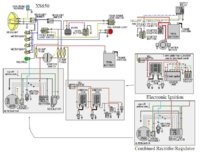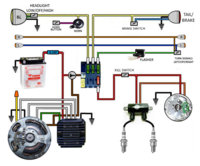nb1914
XS650 Addict
Deep breath……..ok what do i have, from the stator i have a loom with 4 wires
3x brown ( PO has jointed so assume these are white at the stator )
1x back ( assume earth )
I also have 2 shorter wires both White
I have a REG/REC with
3x white
1x red
1x black
1x green
1x brown
From the tech section wiring diagrams i can deduce that from bike wiring that, i would do as follows
connect the 3x brown from the stator to the 3x white on the REG/REC, connect the black from the stator to earth somewhere.
I would connect the Red from the REG/REC to the battery positive maybe after an inline fuse. I would connect the black from the REG/REC to earth somewhere. I would connect the brown from the REG/REC to the positive rail after ignition switch.
That leaves the green wire from the REG/REC and the 2 shorter white leads from the stator. from the tech section one simplified diagram shows the green and another brown connection from the REG/REC connecting to something which isn't labelled.
previous to this the bike had separate Regulator and Rectifier modules. At present I'm assuming that the green and another brown connection go to the 2 shorter white cables from the stator, would that make sense and what are they for, does it matter which one green goes to or brown goes to.
3x brown ( PO has jointed so assume these are white at the stator )
1x back ( assume earth )
I also have 2 shorter wires both White
I have a REG/REC with
3x white
1x red
1x black
1x green
1x brown
From the tech section wiring diagrams i can deduce that from bike wiring that, i would do as follows
connect the 3x brown from the stator to the 3x white on the REG/REC, connect the black from the stator to earth somewhere.
I would connect the Red from the REG/REC to the battery positive maybe after an inline fuse. I would connect the black from the REG/REC to earth somewhere. I would connect the brown from the REG/REC to the positive rail after ignition switch.
That leaves the green wire from the REG/REC and the 2 shorter white leads from the stator. from the tech section one simplified diagram shows the green and another brown connection from the REG/REC connecting to something which isn't labelled.
previous to this the bike had separate Regulator and Rectifier modules. At present I'm assuming that the green and another brown connection go to the 2 shorter white cables from the stator, would that make sense and what are they for, does it matter which one green goes to or brown goes to.





